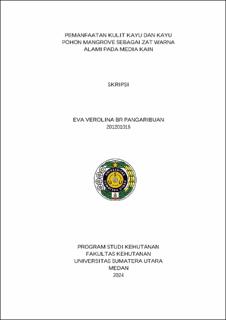| dc.description.abstract | The textile industry is one of the contributors to waste in the world including
liquid dye waste. The use of natural dyes can be an alternative to reducing such
waste. Indonesia has extensive mangroves, reaching around 3,364,080 Ha. The
majority of North Sumatra mangrove forests are located in Langkat Regency with
an area of about 45,909 ha. Utilization of mangroves as natural dyes helps in the
use of mangrove ecosystems without causing damage, because what is used is the
unused part. This study aims to evaluate the potential of bark and wood of tengar
(Ceriops tagal), nyiri (Xylocarpus granatum), oil mangrove (Rhizophora
apiculata) trees as textile dyes and analyze the ability of dye bark and wood of
tengar, nyiri, oil mangrove as antibacterial agents, antioxidants, phenolics and
application to fabrics. This study consists of two factors, namely tree parts (bark
and wood) and tree species (tengar, nyiri, oil mangrove). Based on the test
results, the best phenolic value on tengar bark is 40.35 mg/g. Fabric fastness after
washing the best ecoprint fabric (small category) nyiri bark is worth 2.41.
Antioxidant activity of the best extract on nyiri bark 89.14%, fabric before
washing on tengar bark (dyed fabric) worth 98.41%. The best fabric after
washing on tengar bark (ecoprint fabric) is 71.54%. The antibacterial activity of
Staphylococcus aureus in the best extract on tengar bark was 10 mm. On the
fabric before washing, the best on nyiri bark (dyed fabric) was 2 mm, but not
detected on ecoprint fabric (wood). Antibacterial Propionibacteium acnes on the
best extract on tengar bark 5.33 mm and on the fabric before washing the best on
nyiri wood (ecoprint fabric) of 2.33 mm is not found on the dyed fabric (wood).
Antibacterial fabric after washing is only found on fabrics with bark code. | en_US |


